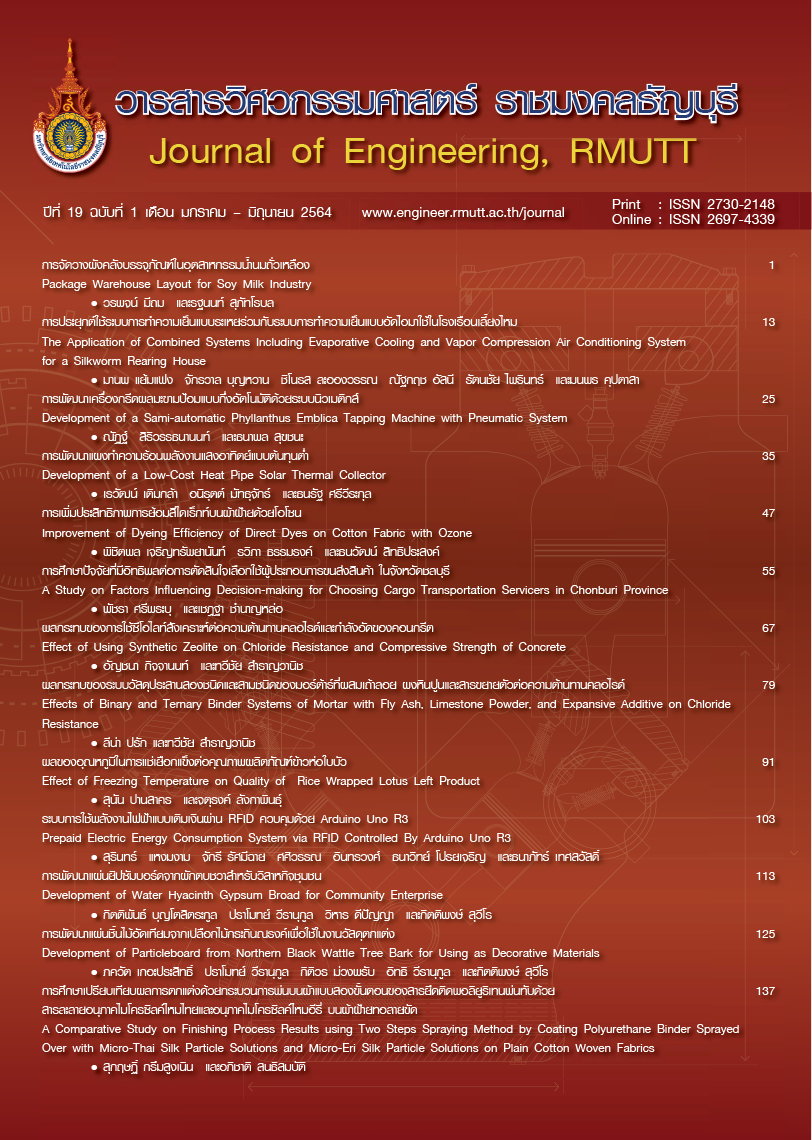Development of Water Hyacinth Gypsum Broad for Community Enterprise
Main Article Content
Abstract
This research aims to develop the gypsum broads from water hyacinth for community enterprise. The 9 ratios of mixture were design which included 3 ratios of water hyacinth gypsum broads, 3 ratios of water hyacinth gypsum broads mixed with Portland cement type 1, 3 ratios of water hyacinth gypsum broads mixed with Portland cement type 1 and pre vulcanized latex. These gypsum broads were casted in molds and were tested by using the TIS.219-2009 (No moisture resistant property type). According to the results, the proper volume of water hyacinth in gypsum broads effected to decrease the density, water absorption, and thermal conductivity properties of gypsum broads and also increase the breaking strength, and nail withdrawal properties of gypsum broads. The 0.75: 0.25: 0.0075: 0.05: 0.003: 1 by weight of gypsum plaster: Portland cement type 1: water hyacinth: pre vulcanized latex: non-ionic surface active agent: water ratio was the suitable ratio and passed the standard. It had the properties included 896.30 kg/m3 of density, 51.70 % of water absorption, 219.58 g/m2 of surface water absorption, 653.50 N of longitudinal breaking strength, 384.41 N of transverse breaking strength, 4.48 mm of deflection, and 0.195 watt/m.K of thermal conductivity. And this gypsum board was used as same as the common gypsum board and was able to produce by local communities.
Article Details
The manuscript, information, content, picture and so forth which were published on Frontiers in engineering innovation research has been a copyright of this journal only. There is not allow anyone or any organize to duplicate all content or some document for unethical publication.
References
Weeranukul P, Suweero K., Weeranukul I. Coconut coir ceiling board product with thermal insulation property. Journal of Engineering, RMUTT. 2018;16(2):129-38. (in Thai)
Jindaprasert P, Jaturapitakkul C. Cement, Pozzolan, and Concrete. Bangkok: ACI Partners with Thailand Concrete Association; 2012. (in Thai)
Ohama Y. Principle of latex modification and some typical properties of latex-modified mortars and concretes. ACI Materials Journal. 1987; 84(45):511-8.
Weeranukul P, Suweero K, Weeranukul I. Coconut coir ceiling board product with water resistance and thermal insulation property for local communities. Proceedings of the 11th National Conference of Rajamangala University of Technology; 2019 Jul 24-26; Chiang Mai: Chiang Mai International Convention and Exhibition Centre. Chiang Mai: Rajamangala University of Technology Lanna; 2019. p.244-59. (in Thai)
Khamput P. Study of physical and mechanical of concrete block mixed with Para latex. Full Report. Bangkok: Thailand Research Fund; 2007. (in Thai)
The Secretariat of the Prime Minister. Water Hyacinth [Internet]. Bangkok: The Secretariat of the Prime Minister. 2020 May 20 [cited 2020 Oct 1]. Available from: https://spm.thaigov.go.th/CRTPRS/spm-sp-layout6.asp?i=31111%2E13614702112113121111311. (in Thai)
Ghosh SR, Saikia DC, Goswami T, Chaliha BP, Baruah JN. Utilization of water hyacinth (Eichhornia crassipers) for paper and board making. Proceedings of the International Conference on Water Hyacinth; 1984 Feb. 7-11; Nairobi: UNEP: UNEP; 1984. p.436-60.
Thai Industrial Standards Institute (TISI). Thai Industrial Standard No.219-2009: Gypsum Board. Bangkok: TISI; 2009. (in Thai)
American Society for Testing and Materials (ASTM). Annual Book of ASTM Standards. Philadelphia: ASTM; 2012.
Davies RM, Mohammed US. Moisture-dependent Engineering Properties of Water Hyacinth Parts. Singapore Journal of Scientific Research. 2011;1:253-63.
Faherty KF, Williamson TG. Wood Engineering and Construction Handbook. New York: McGraw-Hill, Inc.; 1995.
Young HD. Hyper Physics. Addison Wesley: University Physics.; 1992.
Barlow FW. Rubber Compounding: Principles, Materials, and Techniques. New York: M. Dekker; 1993.
Sair S, Mandili B, Taqi M, Bouari AE. Development of a new eco-friendly composite material based on gypsum reinforced with a mixture of cork fibre and cardboard waste for building thermal insulation. Composites Communications. 2019;16:20–4.
Bledzki AK, Gassan J. Composites Reinforced with Cellulose based Fibers. Progress in Polymer Science. 1999;24:221-74.
Park JH, Kang Y, Lee J, Wi S, Chang JD, Kim S. Analysis of walls of functional gypsum board added with porous material and phase change material to improve hygrothermal performance. Energy and Buildings. 2019;183(1):803-16.
Clemens JML. Design, Materials, Compounds, Adhesives, and Substrates [Internet]. PA: Lectrix. 2001 Nov 1 [cited 2020 Oct 1]. Available from: https://www.electronics-cooling.com/2001/11/the-thermal-conductivity-of-rubbers-elastomers/#.
Pakunworakij T, Puthipiroj P, Oonjittichai W, Tisavipat, P. Thermal resistance efficiency of building insulation material from agricultural waste. Journal of Architectural/Planning Research and Studies. 2006;3(4):119-26. (in Thai)


